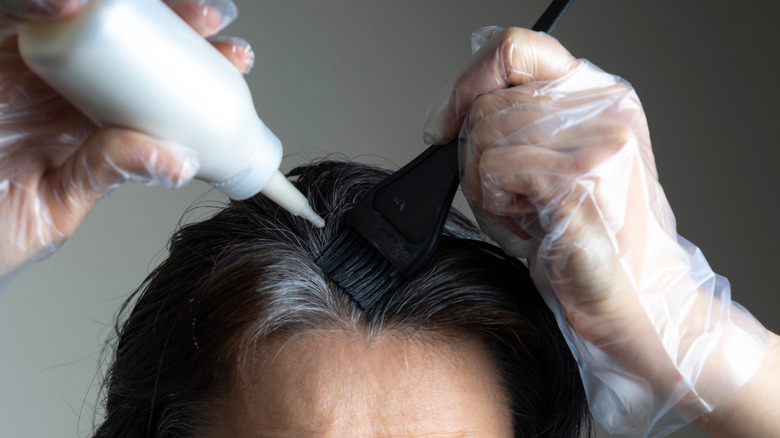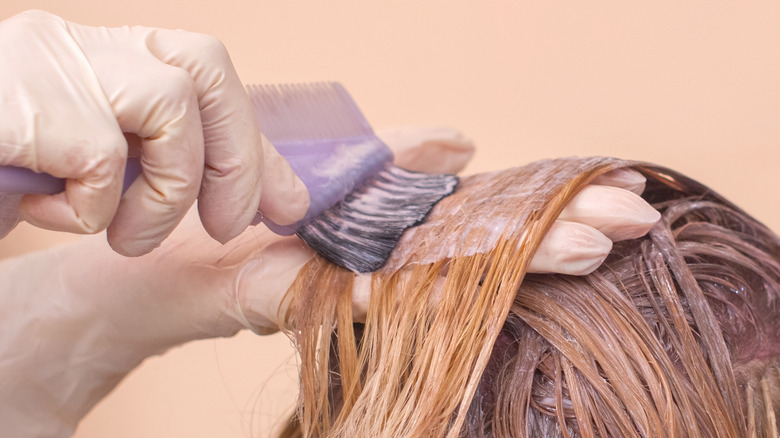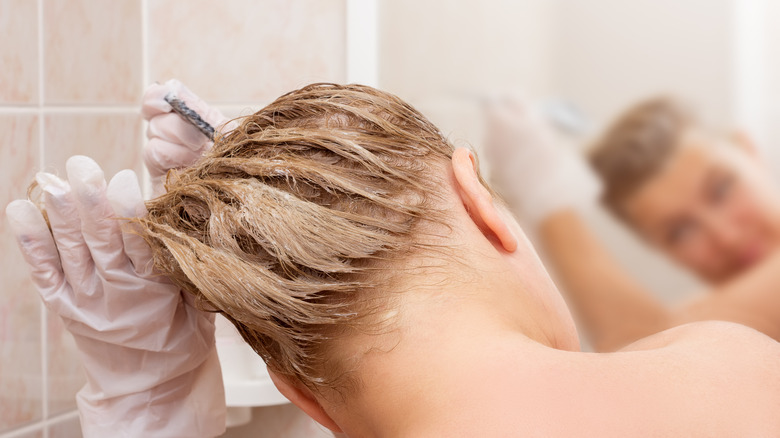Why You Should Try Dyeing Your Hair When It's Wet
Never underestimate the power of hair dye. Hollywood has heavily contributed to hair color stereotypes, such as the blonde bombshell. According to Psychology Today, movies like the Marilyn Monroe-led flick "Gentlemen Prefer Blondes" contributed to the "dumb blonde" stereotype, whereas a decades-old Lady Clairol hair dye advertisement helped popularize the idea that blondes have more fun, per Duke University Libraries.
Hair coloring can be traced back over 3,500 years to ancient Egypt and henna dyes (via Byrdie). Meanwhile, the ancient Greeks and Romans used fermented leeches to create a dark, permanent hair color formula. It wasn't until 1907 that boxed dyes were sold commercially (minus the leeches, of course). Around 50 years after that, thousands of young women bleached their hair in the style of iconic movie star Monroe.
Now, it's easier than ever to dye your hair from the comfort of your own home. The COVID-19 pandemic, specifically, caused quite an increase in at-home hair treatments. According to an SWNS digital survey, over 60% of women said that they're now more likely to manage hair coloring themselves. If you, too, have decided to give yourself an at-home makeover, there are plenty of dyeing mistakes to avoid when coloring your hair at home. But, bucking established convention, is it better to dye your hair when it's wet?
Wet hair is best paired with temporary dyes
If you're looking to permanently bleach or darken your hair, Byrdie recommends dry hair application or, best of all, taking the job to the salon. Precision and full absorption are required for the permanent dye to properly take hold — something that can only be achieved with dry hair. As noted by Penn State, components in permanent dyes like ammonia and peroxide work by penetrating and chemically altering the structure of your hair shaft.
Although it's obviously much cheaper to tackle it yourself, it's also important to understand the risks of using professional hair dyes at home. Fortunately, temporary colors are both less harmful and, as an added bonus, easy to apply in the shower. Because semi-permanent dyes contain neither ammonia nor peroxide, and demi-permanent colors are mixed with only small amounts of ammonia, they're more able to cling to wet hair (via Stylecraze).
As Byrdie points out, these dyes can be used more sparingly on wet hair too. In fact, water will help to fully distribute the pigment, meaning that you'll need far less to evenly coat your strands. Keep in mind, however, that colors used on wet hair might not come out quite as bright.
Don't apply color directly after bleaching
Wet hair might also be harder to manipulate. According to celebrity stylist Nick Stenson, "Water acts as a diluting agent. Not to say that coloring wet hair should be considered 'wrong,' but it does prevent the color from lifting or depositing to its full capacity, which will affect the longevity and life of the color," (via Healthline). Likewise, adding color right after bleaching your hair can cause breakage. So, if you're hoping to incorporate a little pigment, hold off.
Stylecraze recommends waiting up to two weeks before spicing up your chemically-treated look at home, especially if you're dyeing your hair when it's wet. Once you do get in the shower, though, it's a relatively easy process. Your hair dye's packaging should come with its own set of instructions, but most steps are more or less the same. In the shower, wet your hair with warm water but don't shampoo it just yet.
Next, squeeze excess water out of your hair using a towel or simply wring with your hands since, as Healthline warns, dye will slip off super-wet hair. Following this is the application stage. Massage in the dye wherever you want pigment. Instructions usually dictate that the color sits untouched for about 20 minutes (keep it off your neck and back by putting on a plastic shower cap). Finally, after rinsing, use a color-safe shampoo to preserve the pigment for longer.


